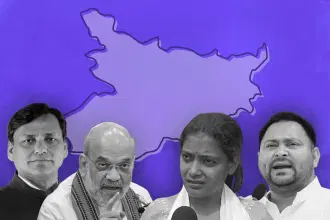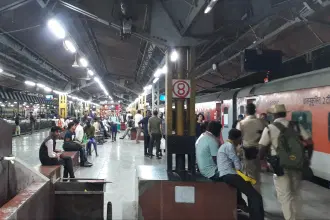Economy
From Promise To Pitfall: Inside The Ethanol Backlash On Indian Roads
Amit Mishra
Aug 07, 2025, 11:17 AM | Updated Sep 01, 2025, 03:33 PM IST
Save & read from anywhere!
Bookmark stories for easy access on any device or the Swarajya app.


If you've spent any time on Twitter lately, chances are you've come across the growing storm over India's Ethanol Blending Programme (EBP).
Industry experts, auto enthusiasts, and everyday commuters alike are voicing sharp concerns, chief amongst them, that the E20 petrol blend causes about a drastic drop in mileage, especially in cars, and damage to the fuel tank and engine.
The backlash has grown so intense that the Ministry of Petroleum and Natural Gas (MoPNG) was recently compelled to issue a detailed, point-by-point clarification on social media.
But for many Indians behind the wheel, the damage, both mechanical and emotional, may already be done. Clearly, it's time to move past the noise and unpack what's really happening. But first, some context.
Ethanol: The Biofuel with Big Promises
Ethanol, also known as ethyl alcohol, is a clear, colourless, volatile liquid with a distinctive smell. Whilst most people associate it with alcoholic beverages, ethanol is also widely used as a biofuel. It can be produced from a variety of renewable sources such as sugarcane, corn, wheat, barley, and even agricultural or forest waste. In the world of energy, it's seen as a cleaner, greener cousin to fossil fuels.
In the context of automotive fuel, ethanol is typically blended with petrol to create variants such as E10, E15, and E20, or alternatively used as a standalone fuel in engines specifically designed for it. The E20 blend, comprising 20 per cent ethanol and 80 per cent petrol, is the current focus in India's fuel policy.
India's Ethanol Blended Petrol (EBP) programme began as a pilot initiative in 2001. At the time of its inception, the EBP had set the target of 20 per cent blending to be achieved by 2030. Remarkably, India achieved this 20 per cent blending milestone in March this year, a full five years ahead of the original 2030 deadline.
When the Rubber Meets the Road: The Consumer Backlash
Instead of celebrating the E20 rollout as a climate victory, vehicle owners are grumbling at their mileage meters. The maths is maddening: cars that used to offer 15 km per litre now manage barely 11.5. That's a whopping 25 per cent drop in fuel efficiency.
A LocalCircles survey, spanning 315 districts and over 36,000 petrol vehicle owners, confirms the worry isn't anecdotal, it's widespread. The survey found that two in three owners of vehicles purchased in 2022 or earlier reported lower fuel efficiency in 2025 compared to previous years.
Amongst vehicle owners surveyed, two in three with cars purchased in 2022 or earlier reported lower fuel efficiency in 2025 compared with previous years:
22 per cent saw mileage drop 15–20 per cent
22 per cent reported declines above 20 per cent
11 per cent saw a 10–15 per cent drop
Smaller percentages reported lesser declines
Only 11 per cent said there was no impact
What stings more is that the fuel costs remain unchanged. Consumers are paying the same price per litre as they did for 100 per cent petrol, but getting far less distance in return, effectively spending more to go the same distance.
In fact, the MoPNG also acknowledged the drop in fuel economy due to the use of E20 fuel, but said that the decrease was only "marginal".
"Ethanol, being lower in energy density than petrol, results in a marginal decrease in mileage, estimated at 1–2% for four-wheelers designed for E10 and calibrated for E20, and around 3–6% in others. This marginal drop in efficiency can be further minimised through improved engine tuning and use of E20-compatible materials, which leading automobile manufacturers have already adopted," the MoPNG said in its post on social media platform X.
Are Older Vehicles at Risk?
That's where the situation turns more problematic. Most vehicles produced in India before 2023 are not compatible with ethanol mixed petrol and can cause damage to them and reduce fuel efficiency (mileage).
According to vehicle manufacturer Hero Motocorp, using E20 on non-compliant/older vehicles may lead to several disadvantages.
"Older vehicles, manufactured prior to April 2023, may require modifications in the Engine-Fuel system for it to be tuned to run efficiently on E20 fuel. Certain rubber, elastomers and plastic components (like gaskets, O-rings, Fuel Tubes, etc.) may need to be replaced for prolonged usage with new parts made with E20 compatible materials," it has said.
The company is not alone in making these observations; several other vehicle manufacturers have also pointed out the adverse effects of blending ethanol with petrol.
"Compared to gasoline, ethanol has different chemical characteristics, and it is corrosive to several materials that are frequently used in fuel systems. Component deterioration or damage could result from compatibility problems," TVS noted.
"Because of its hygroscopic qualities, ethanol can draw moisture from the surrounding air. Phase separation brought on by this water absorption may result in corrosion if the manufacturer doesn't account for it. Intensive farming methods used to produce ethanol may be a factor in environmental problems such as soil erosion, pesticide use, and deforestation. Utilising sustainable farming methods is essential to reducing these effects," it added.
Even international brands reflect similar caution. Owner manuals of 2022 and 2025 Mazda3 and Mazda CX-90 models explicitly recommend against using ethanol blends higher than E10. And yet, here in India, E20 is being pumped into tanks without warning, let alone consent.
To be fair, the Society of Indian Automobile Manufacturers (SIAM) has confirmed that E20-compliant vehicles with upgraded components began rolling out from April 2023. But the push for E20 may be outpacing the ground reality of India's existing vehicle fleet.
Policy vs. People: A Disconnect Widening
Fuel stations haven't helped matters. Across the country, consumers report the opacity at petrol pumps regarding the type of fuel they were getting, where no clear communication exists about the blend levels. Many don't even realise when they've made the switch, only to discover the change after noticing a drop in mileage.
Adding to this frustration is the pricing issue. Ethanol is significantly cheaper to produce than petrol. So why is E20 being sold at the same price as regular petrol? For many, this feels like a hidden cost, consumers are being made to pay more for a policy decision they didn't opt into.
And unlike other countries, where consumers are allowed to choose between ethanol-blended and unblended fuel (or where blending is done only with compatible vehicles), India has taken an all-in approach, making E20 mandatory even for vehicles not designed to run on it. This has led to accusations of a "one-size-fits-all" policy that disregards millions of legacy vehicles still plying Indian roads.
Most countries take a more cautious, consumer-first approach. The U.S. offers a choice between regular and ethanol-blended fuels.
Brazil, a pioneer in ethanol, ensures vehicles are flex-fuel compatible before mandating change. According to Bloomberg reports from 2023 and 2025, flex-fuel vehicles that can run on any proportion of gasoline (E20-E25 blend) and hydrous ethanol (E100) dominate the Brazilian market, constituting approximately 84.5 per cent of all vehicle sales as of 2025.
The Economics
There's also a glaring disconnect between the promise and the reality. Whilst one of the key arguments for ethanol blending is cost savings, particularly from reduced crude oil imports, these savings have not been passed on to the public.
According to MoPNG, ethanol blending has already saved India over Rs 1.4 lakh crore in foreign exchange through petrol substitution and helped reduce carbon dioxide emissions by 700 lakh tonnes. Additionally, over Rs 1.2 lakh crore has been paid to farmers, thereby creating income and employment opportunities in the agricultural and biofuel sectors.
These are commendable achievements, but the benefits feel abstract to everyday consumers who are left footing higher bills and dealing with compatibility issues.
At a 2018 rally in Durg, Union Minister Nitin Gadkari painted a rosy picture of the future: "Our Petroleum Ministry is setting up 5 ethanol-making plants in the country. Ethanol will be produced from wood products & segregated municipal waste. Diesel will be available at Rs. 50 per litre & petrol alternative at Rs. 55 per litre."
Yet, petrol prices in most Indian cities remain above Rs 100 per litre. The savings, it seems, haven't trickled down.
The Case for Consumer Choice
At its core, the backlash against E20 reflects a deeper discomfort with the way the policy has been implemented. Consumers are not questioning the intent, few would argue against reducing emissions or supporting farmers, but they are demanding transparency, fairness, and most importantly, choice.
Give people clear information. Let them decide whether to use E20 or stick with conventional petrol. And ensure that pricing reflects the actual production cost and energy content of the fuel, not just policy ambitions.
In the rush to go green, the government may have moved faster than the country was prepared for. And whilst the Ethanol Blending Programme may still deliver long-term gains, ignoring consumer voices risks turning a promising transition into a public relations disaster.
India deserves a cleaner future, but one that doesn't come at the cost of consumer trust.





